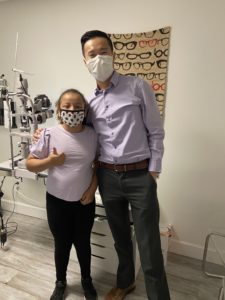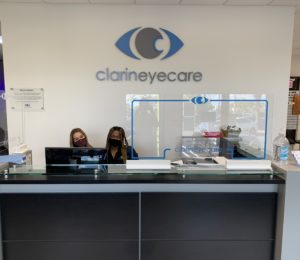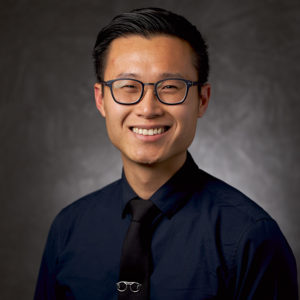June 1, 2021
By Eric Chow, OD, FAAO; Clarin Eye Care and Coral Gables Eye Care Center, Miami, FL
Parents want what’s best for their children, and giving them the right resources to do their research is vital to make an informed decision they won’t regret later.

Dr. Chow with a myopia management patient.
Throughout my career in the eye care field, I’ve garnered experience in corporate optometry, management, and private practices. In that time, I’ve seen firsthand the benefits of implementing myopia management services and the ways that these treatments can change the trajectory of patients’ lives. Now practicing in two independent practices, I can dedicate my time to treating young children and focusing on vision therapy and myopia management.
Over the last several years, I have noticed the growing number of myopic children and the alarming rate at which their prescriptions were increasing year after year. This observation motivated me to establish a myopia management practice. While my process was extensively research based, I learned that seeing success comes down to providing the right resources and offering all available options. Moreover, parents must educate themselves on myopia management and be active in the decision-making process for their children.
Starting a Myopia Management Treatment Plan
When evaluating a patient with myopia, I always start with an extensive exam. This will typically include a binocular vision screen, a cover test at distance and near, retinoscopy, and ocular motility. The combination of these tests can uncover functional vision issues that can be contributing to their myopic risk profile. It’s also important to incorporate details such as the child’s family history of myopia, axial length measurement, and their annual myopic change.
When I first started offering patients myopia management treatments, I was prescribing low-dose topical atropine. Based on results from the LAMP and ATOM2 studies, I felt confident prescribing it to my patients. Over time, I saw impressive results from my patients who were diligent about using eye drops every night before bed. From there, I moved into dual-focus contact lenses, which also produced favorable results. This includes lenses such as CooperVision’s MiSight 1 day, NaturalVue, and Biofinity multifocal center distance lenses. I also offer patients therapeutic lenses, including prism, near plus, and vision therapy. While I like to start with one treatment modality, if a child’s myopia is still progressing rapidly at the six-month follow-up, I’ll consider adding a second treatment at that point.
A big part of determining the myopia management treatment plan is assessing the patients’ and parents’ level of compliance and responsibility. A child who doesn’t have the maturity to insert and remove a contact lens safely, or sleep in an orthokeratology lens, leaves us with low-dose atropine, therapeutic spectacles, or vision therapy. A child with esophoria, high AC/A, and a functional myopia component might benefit most from vision therapy or yoked prism spectacles.
Regardless of which treatment we choose, axial length is a good indicator of whether that modality is working. The Tideman study from 2018 shows that children in the lowest percentile of axial length had relatively little increase after age six. Those who start with a higher axial length at that age progress more rapidly. This study is great because it provides normative values for axial length compared to age and gender norms.
Utilizing Social Media to Educate Parents
Every patient and parent comes into the office with a different knowledge base and expectations, making the myopia education process difficult. Though I discuss my findings with children and their parents in the exam room and provide the pros and cons of each myopia management option, it’s always up to the parent to decide what’s best for their child. Some parents are already on board before I even bring up the treatment options and are willing to go with whatever I recommend. Other parents who have never heard about myopia management before might have more questions and ask for evidence. Parents want what’s best for their children, and giving them the right resources to do their research is vital to make an informed decision they won’t regret later.

Clarin Eye Care in Miami, FL
To make this process easier for myself, my fellow eye care professionals, and parents, I made a YouTube video earlier this year that breaks down myopia, the risk factors, the available treatment options, and what parents can start doing as soon as possible to improve their children’s vision. I found myself repeating the same things to patients and parents over and over and thought that creating this video would streamline this process in my day-to-day work and for others. The video includes resources such as the CooperVision Myopia Simulator, BHVI’s Myopia Calculator, and articles from Vista Eye Care, The Eye Practice, Modern OD, and Eye Bar.
Parents not only hear from me in the video, but they can also go beyond the information I provide and do their own research. Since creating and sharing it this past March, it’s been a very useful tool for me, and I’ve gotten a lot of positive feedback from parents. They enjoy that they can reference it as many times as they need to and that I took the time to make the video — and it makes my job easier. My goal moving forward is that it can help make other ECPs’ jobs easier too. Sometimes it takes hearing something from a different professional to bring the point home for parents.
Overall, social media has played a tremendous role in disseminating information to patients and their parents. The research and studies are there, and we need to embrace what science is telling us and provide these options to patients and their parents. They can, and will, look it up themselves online, so you don’t want to be caught saying nothing can be done about a child’s myopia.
Doing Our Part for Our Patients
Starting a child on a myopia management program will change their life trajectory and prevent them from having potential limitations in their lives. For example, a child who is projected to reach degenerative levels of myopia may be excluded from being a candidate for LASIK surgery or becoming a firefighter, police officer, or pilot. Controlling a child’s myopia now will reduce that child’s risk of developing vision-threatening eye diseases later in life.
As eye care professionals, we need to feel comfortable talking about myopia management and recommending evidence-based options to help reduce the progression of myopia in at-risk children. Prescribing stronger single-vision eyeglasses every six months to progressive myopes is no longer the standard of care.

Dr. Eric Chow was born in Hong Kong, grew up in Queens, NY, and is now a resident of Miami, FL. He graduated from SUNY College of Optometry in 2016 and completed a residency in pediatrics and binocular vision from NOVA Southeastern College of Optometry in 2017. Dr. Chow is a fellow in the American Academy of Optometry and a board member of the Miami Dade Optometric Physicians Association.













